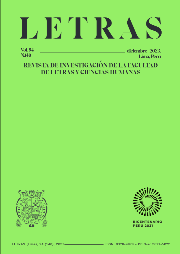El Proletarian art in four sculptures by Carmen Saco Arenas
Abstract
This research analyzes the representation of Proletarian art in four sculptures by the peruvian artist Carmen Saco Arenas (1882-1948). Based on the artist's statements about her desire to create a Proletarian art, and also on the development and problematics of this artistic movement that arises from the beginning of the Soviet revolution, we seek to understand and explain the aesthetic and contextual conditions in which Saco Arenas produced her sculptural works. In the first place, the life of the sculptress is examined, focusing on her artistic training as well as her political militancy, to then analyze the movement of Proletarian art and its characteristics within the Marxist doctrine. Lastly, we carried out a formal analysis of four sculptural creations by the artist, dated approximately in the third decade of the 20th century. This study also allows us to have some light on how this international movement developed in the local context of the city of Lima at that time. As a result, it is shown that Saco Arenas conceived a particular version of Proletarian art, following the essential values of this avant-garde, but, in turn, framed in the Peruvian context of the early 20th century and influenced by the Indigenism movement.Downloads
Métricas alternativas
References
Clerici, A. (s. f.). Carmen Saco (1882-1948). https://www.mcnbiografias.com/app-bio/do/show?key=saco-carmenhttp://www.mcnbiografias.com/app-bio/do/show?key=saco-carmen.
Clerici, A. (1996). Die erste Etappe der peruanischen Frauenbewegung. Ein Überblick vom ersten feministischen Grundsatzprogramm im Jahre 1911 bis zur Gewährung des Frauenwahlrechts im Jahre 1955 (Primera etapa del movimiento de mujeres peruanas. Un repaso desde el primer programa básico feminista en 1911 hasta la concesión del sufragio femenino en 1955). [Tesis Romanisches Seminar], University of Zurich.
Beigel, F. (2003). El itinerario y la brújula. El vanguardismo estético- político de José Carlos Mariátegui. Editorial Biblos.
Berninsone, L. (1925, 7 de noviembre). La escultora nacional Carmen Saco. Variedades, 21(923), 3595-3596.
Calvo, M. (2017). La Revolución rusa y cómo revolucionó el arte moderno. Historia-Arte. https://historia-arte.com/articulos/la-revolucion-rusa-y-como-revoluciono-el-arte-moderno
Escobar, H. (2018). La influencia de Daniel Hernández en el lenguaje visual de sus estudiantes y los inicios de la
Escuela Nacional de Bellas Artes (1919-1931). [Tesis para optar el grado de magíster en Historia del Arte y Curaduría], Pontificia Universidad Católica del Perú. http://hdl.handle.net/20.500.12404/12910
Facultad de Arte y Diseño PUCP. (2021, 9 de diciembre). Esculturas del campus PUCP. https://facultad.arteydiseno.pucp.edu.pe/noticias-y-eventos/contentnoticiaevento/esculturas-del-campus-pucp/
García y García, E. (1925). La mujer peruana a través de los siglos, tomo II. Imprenta Americana. https://ufdc.ufl.edu/aa00019316/00002.
Lucena, D. (2006). Cultura proletaria y vanguardia rusa. Discusiones en torno a la construcción de un nuevo mundo. Universidad de Buenos Aires, Consejo Nacional de Investigaciones Científicas y Técnicas. https://core.ac.uk/download/pdf/17338727.pdf
Lugo, F. (2017). Trotsky y el arte proletario. La izquierda socialista. https://marxismo.mx/trotsky-arte-proletario/#_ftnref8
Lunacharsky, A. (2000 [1918]). Proletariado y arte. I Conferencia de Organizaciones de Cultura Proletaria de Toda Rusia realizada en Moscú, 15-20 de septiembre de 1918. Marxist Internet Archive. https://www.marxists.org/espanol/lunacha/obras/arte.htm
Saco, C. (1925, 10 de enero). Recuerdos de viaje. Roma, la ciudad de las fuentes. Variedades, 21(879), 34-40.
Saco, C. (1925, 8 de mayo). Estética de la fealdad. Mundial, 5(256), 5-6.
Saco, C. (1927, mayo). La altura elemento estético. La torre Eiffel. Amauta, 9, 24.
Saco, C. (1927, diciembre). Moscú, la ciudad mística. Amauta, 11, 37.
Saco, C. (1928, febrero). José de la Solana. Amauta, 12, 12.
Saco, C. (1929, septiembre-octubre). Balance sumario de Bourdelle. Amauta, 26, 54-56.
Saco, C. (1929, noviembre-diciembre). Sugestiones del arte de Julia Codesido. Amauta, 27, 17-20.
Tauzin-Castellanos, I. (2018). L’art indigéniste au féminin: Julia Codesido, Elena Izcue et Carmen Saco. Artelogie, 12. https://doi.org/10.4000/artelogie.1983
Trotsky, L. (2002 [1937]). Literatura y revolución. Marxist Internet Archive. https://www.marxists.org/espanol/trotsky/1920s/literatura/indice2.htm
Vallejo, C. (1973). El arte y la revolución. Obras Completas, tomo II. Primera edición. Mosca Azul Editores. https://fundacionbbva.pe/wp-content/uploads/2016/04/libro_000013.pdf
Variedades. (1925, 19 de septiembre). ¿Qué prepara usted? Variedades, 916, 3113.
Variedades. (1929, 3 de julio). El triunfo de Carmen Saco en España. Variedades, 1113, s/p.
Villegas, F. (2013). Vínculos artísticos entre España y Perú (1892-1929): Elementos para la construcción del imaginario nacional peruano. [Tesis doctoral], Universidad Complutense de Madrid. https://hdl.handle.net/20.500.14352/37835
Vocnović, S. (s. f.). Movimiento de arte del realismo socialista: historia, artistas y obras de arte. Artlex. https://www.artlex.com/es/movimientos-artisticos/realismo-socialista/
Copyright (c) 2023 Letras (Lima)

This work is licensed under a Creative Commons Attribution 4.0 International License.
Este obra está bajo una licencia de Creative Commons Reconocimiento 4.0 Internacional



















